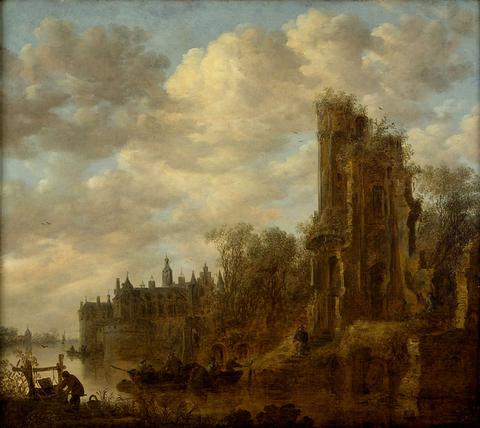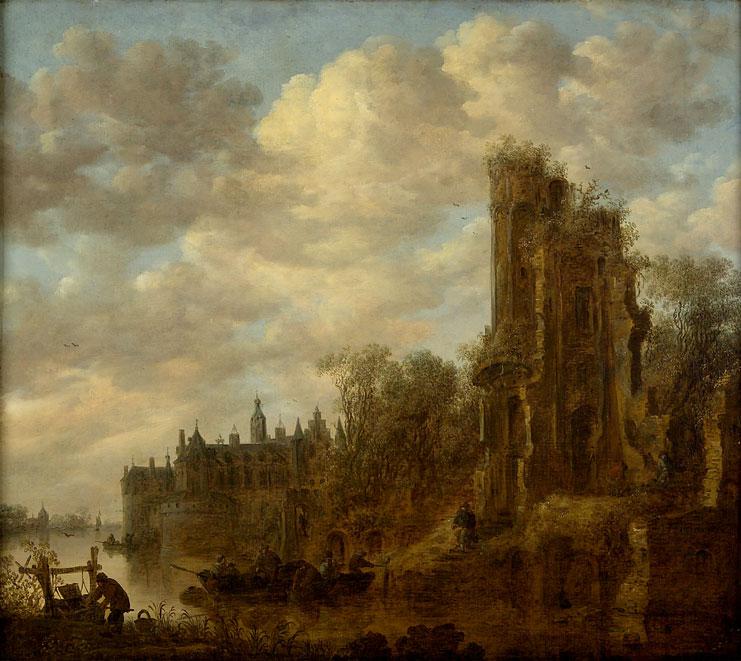
Paysage fluvial avec château et tour en ruine
Jan van Goyen (1596 Leyde - 1656 La Haye)
1650
Huile sur toile ; signée et datée « J VGOYEN 1650 » en bas à droite ; 96 x 107 cm
Provenance :
Johan Adriaen Versijden van Varick ; Leyde, vente anonyme, 29 octobre 1791 ; Stockholm, Olof Granberg, conservateur au musée de Stockholm (catalogue 1917, n° 4) ; Stockholm, consul Karl Bergsten (catalogue 1925, n° 21) ; Londres, Sotheby's, 24 mars 1976 ; Sud-Ouest de la France, collection privée ; Toulouse, Primardeco, 19 octobre 2009.
Exposition :
Dutch Art (Londres, Royal Academy, 1929) ; Dutch Masters (Stockholm, 1967).
Bibliographie :
Hans Ulrich Beck, Catalogue raisonné, vol. II, 1973, n° 702, p. 320 ; Hans Ulrich Beck, Catalogue raisonné, vol. III, 1987, n° 702, p. 227 (reproduit).
Bibliographie comparative : George S. Keyes, « Jan van Goyen's River Landscape », The Minneapolis Institute of Arts Bulletin, 1983.
Jan Van Goyen est, avec Salomon van Ruysdael, l’un des deux grands de la première génération des paysagistes hollandais de ce qu'on appellera le Siècle d’Or. Lorsqu’il peint ce tableau en 1650, il a cinquante-trois ou cinquante-quatre ans. Peintre et bourgeois, il investit dans l’immobilier. Il a marié ses deux filles – l’une d'elles au peintre Jan Steen – l’année précédente, et l’année suivante il recevra la commande prestigieuse, pour l’Hôtel de Ville de La Haye, d’une vue panoramique. Ce bonheur domestique est le reflet du bonheur d'un peuple. En 1648, le traité de Münster a consacré l’indépendance des Provinces-Unies. Le tableau de paysage se fait alors, d'un mot de l’historien d’art Wolfgang Stechow qui traduit l'esprit de ces années où naît un État : « stately », majestueux.
Van Goyen voyage, remplit ses carnets de dessins. Il peint moins, mais plus grand, laisse aller son imagination, recompose le paysage. Ici un château qui s'inspire de celui de Montfoort, près d'Utrecht (qui sera détruit par les Français en 1672), côtoie une ruine dont la situation sur le fleuve est celle de la Pelkus-poort, près d’Utrecht également, mais dont l’architecture est celle de la Huis te Merwede, près de Dordrecht. Comme l'écrit George S. Keyes à propos du Paysage fluvial (1648) du musée de Minneapolis : « Van Goyen célèbre le riche héritage de la jeune République, aussi bien naturel qu'architectural – le pays lui-même, soumis aux forces de la nature et conquis sur les champs de bataille, et quelque édifice vénérable, construit de main d'homme et enraciné dans l'histoire d'un peuple ».
Dans un format presque carré, une double diagonale structure le tableau. Un pêcheur ouvre un casier à poissons, un bac accoste. Le tout reprend une formule de composition d'Esaias van de Velde, le premier maître de Van Goyen, qui comme l'écrit Wolfgang Stechow « concentre notre attention pour éviter qu'elle ne parte au fil de l'eau ». Mais il y a plus : la douceur, la brise, l’humidité. Cela, c'est l'apport de van Goyen.
Au même moment, exactement, que Claude Lorrain à Rome, van Goyen allie paysage et peinture d’histoire. Une architecture idéale, ou fantasmée, donne à la scène une solennité sereine. Ici, simplement, ce ne sont pas une reine et sa suite qui embarquent, mais des paysans qui débarquent...
